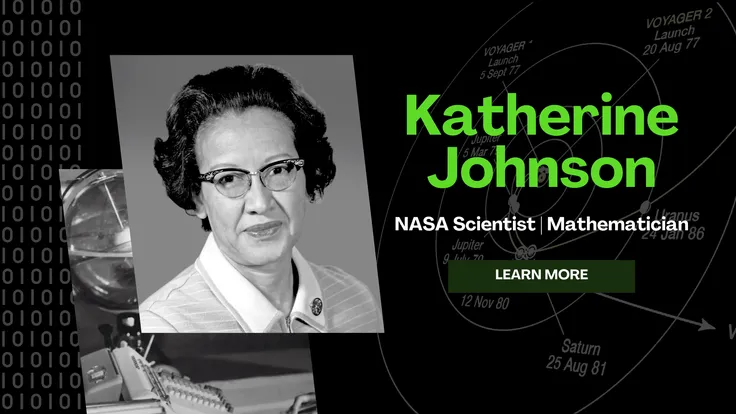Katherine Johnson was an American mathematician who solved calculations for the first and subsequent U.S. crewed spaceflights. She was born on August 26, 1918, in West Virginia. Johnson showed strong mathematical abilities from an early age. Unfortunately, her school district didn’t offer public schooling for African American students, so her family arranged for their children to attend a high school in Institute, West Virginia. After graduating from high school at 14, she went to WVSC. There she took every mathematics course offered by the college. After graduating, she worked at a black public school in Marion, Virginia.
Johnson’s significance to science and NASA included assisting NASA in sending astronauts to the moon and returning them safely to their homes. Furthermore, she discovered paths for the spacecraft to orbit (go around) Earth and to land on the Moon. Due to her calculations, many aspects of space were uncovered. These discoveries led her to attain the NASA Lunar Orbiter Award and three NASA Special Achievement Awards.
Katherine Johnson, a pioneering mathematician at NASA, specialized in orbital mechanics and made groundbreaking contributions to space exploration. Her complex calculations were crucial for key missions, including John Glenn's orbital flight and the Apollo 11 moon landing.
Johnson received the Presidential Medal of Freedom, which was presented to her by Barack Obama. She was seen as a pioneering example of an African-American woman in STEM. Two NASA facilities have been named in her honor and she won the NASA Lunar Orbiter Spacecraft and Operations Team Award in 1967. She also won the Congressional Gold Medal in 2019 for her contributions to NASA and calculations of space trips.
Through Johnson’s significant work, she broke several gender and racial barriers. During a certain period, countless African Americans stopped attending school after the eighth grade. However, Johnson worked hard through finishing high school and college by the age of 18. At this age, she became the third African American woman to receive a PhD in mathematics.
Furthermore, Katherine and a couple of other African American females heavily contributed to helping the United States achieve the “Space Race”. These intelligent women who have assisted at NASA so much, overcame many instances where they faced extreme discrimination and racial segregation, all while working as human computers and solving complex problems for engineers.
Regardless of the amazing work Johnson has done and the talent she holds, it was not always easy for her. As a female African American being alone, she faced many factors in the workplace, including discrimination, racism, and sexism. Ranging from bathrooms to workspaces, all the above were segregated, and at one point, she was even made to work within a separate wing.
Throughout Katherine’s life, there were numerous instances where individuals would attempt to take credit for her work and achievements. Despite these drastic obstacles, Johnson remained assertive and persistent in her workplace. He was even asked to be a part of an editorial meeting that had never been attended by women before.
All over Katherine Johnson’s life, she has made various impacts within the concepts of gender and racial barriers as well as her aeronautics work within NASA.
Works Cited
The Editors of Encyclopedia Britannica. “Katherine Johnson | Biography & Facts.” Encyclopædia Britannica, 19 Nov. 2018, www.britannica.com/biography/Katherine-Johnson-mathematician.
Wikipedia Contributors. “Katherine Johnson.” Wikipedia, Wikimedia Foundation, 12 Mar. 2019, en.wikipedia.org/wiki/Katherine_Johnson.
Shetterly, Margot Lee. “Katherine Johnson Biography.” NASA, NASA, 22 Nov. 2016, www.nasa.gov/centers-and-facilities/langley/katherine-johnson-biography/.
Editors, Biography.com. “Katherine Johnson - NASA, Death & Hidden Figures.” Biography, A&E; Television Networks, 11 Jan. 2021, www.biography.com/scientists/katherine-g-johnson.
